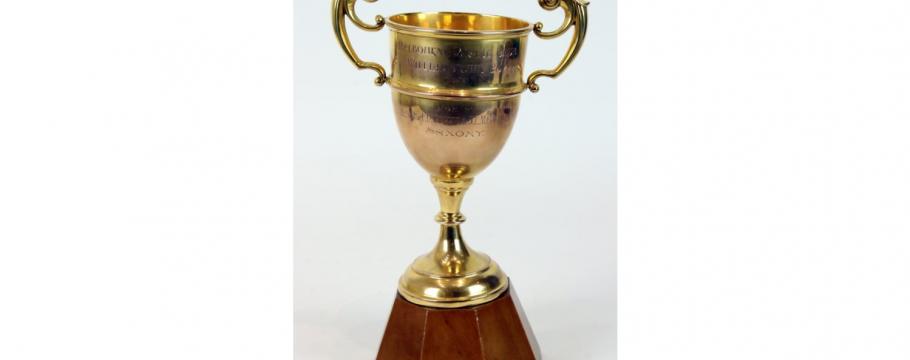








Famous Melbourne horse racing cup a strong auction enticement
Author: Richard Brewster | Posted: 27th March, 2023
When the five-year-old mare Saxony won the 1949 Williamstown Cup, owner Frank Coppin was over the moon.
The last of the four cups run during Melbourne’s Spring Carnival – the others being the Melbourne Cup, Caulfield Cup and Moonee Valley Cup – Frank knew that his horse was in exalted company.
Saxony had already forged an enviable reputation – becoming the first horse to win the mile-long Toorak Handicap, first run in 1881, twice (1948 and 1949).
Only four other horses have won it twice since then – Desert Breeze in 1952/53, Nicopolis in 1963/64, Umrum in 1999/2000 and Solzhenitsyn in 2012/13.
In 1949, Saxony competed in both the Caulfield Cup (where she unfortunately fell but was uninjured) and the Melbourne Cup, not finishing among the top three placegetters, before lining up for the Williamstown Cup – which by then was held at Caulfield.
As luck and fine riding would have it – even though it was the slowest recorded time for the 13-furlong (2615 metres) race – she dashed to the front in the straight, beating Brain by three quarters of a length.
The nine-carat solid gold cup (lot 27), made by the now defunct Melbourne gold and silversmiths Stokes & Drummond and inscribed with the name of the horse along with Frank’s and trainer J.L. Meagher’s names, is an historic memento of both the race and the racecourse.
It is due to be auctioned online, finishing from 10am Monday April 3, at Melbourne-based Philips Auctions 47 Glenferrie Road, Malvern with a catalogue estimate of $15,000-$20,000.
The cup’s origins hark back to 1888 when the first Williamstown Cup (then known as the Zipping Classic) was run at the Williamstown Racecourse, considered one the finest in Australia and established 20 years earlier with an elaborately decorated grandstand facing the sea.
Although many well-known racehorses competed there in the 1920s and 1930s – the most famous being the Australian legend Phar Lap which won the 1931 Underwood Stakes on the course – racing ceased during and after World War II when the venue was used to house troops.
In 1947, a suspicious fire destroyed two of the grandstands. Faced with huge financial difficulties, Williamstown Racing Club members were then forced to amalgamate with the Victorian Trotting and Racing Association to form the Melbourne Racing Club and abandoned the premises – which two years later became home to displaced World War II veterans.
Apart from a few grandstand steps, today nothing remains of the Williamstown Racecourse, now part of Altona Coastal Park.
Daughter Meg Coppin said her father owned and raced several horses in his younger years – the most famous being Saxony and Lord Renwick.
“Once the mare died, he sold his remaining horses,” she said. “He kept about 20 photos of close finishes in which his horses featured that we have donated to the Caulfield Racecourse museum.”
Philips Auctions sale is notable for several other fine pieces including a rare 1920s figurine (lot 50) entitled Les Amis de Toujours by Romanian sculptor Demetre Chiparus (1886-1947) with a catalogue estimate of $40,000-$60,000.
One of the most important art deco sculptors who lived in and worked in Paris, Chiparus’s bronze and ivory works were remarkable for their bright and outstanding decorative effects.
The figurine has two marks on the skirt – one signifying it is made in France and the other containing the initials of the foundry, LNJL (Les Neveux de Joules Lehmann).
The auction also contains furniture, sculptures, vases and paintings from Melbourne socialite, Italian-born Marisa Sillitto – chief executive and driving force behind Sillitto, one of the city’s most exciting import boutiques – and responsible for the first residential home in the CBD.
Her paintings include works by Melchior Paul von Deschwanden (Altarpiece I, Clergyman with choristers, 1874 (lot 273) and (lot 274) Altarpiece II, Communion, 1874) along with paintings depicting nymphs picking grapes.
Among the furniture in her collection is a Japanese black lacquered and gilded Butusudan shrine cabinet (lot 133) and a Japanese bronze koro of Fukurokuyu on a stag (lot 116).
Other attractions include a pair of Chinese carved ivory dragon vases (lot 108), a Chinese porcelain bottle vase on a lacquered stand (lot 142) and a collection of Japanese carved ivory okimono of which lot 96 is a typical example.
Sterling silver also should be of interest to collectors including several Russian, Edwardian and Georgian Kiddish cups such as lot 161.
One of the highlights of the jewellery sale is an almost never seen at auction 18-carat gold Victorian era collier and bracelet (lot 217) from a family estate.





